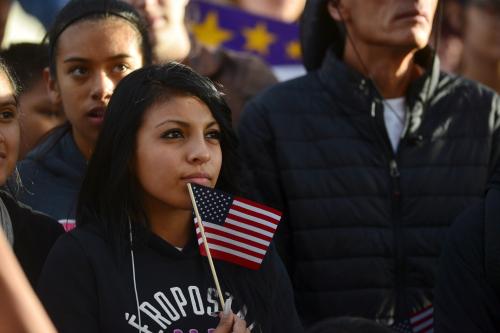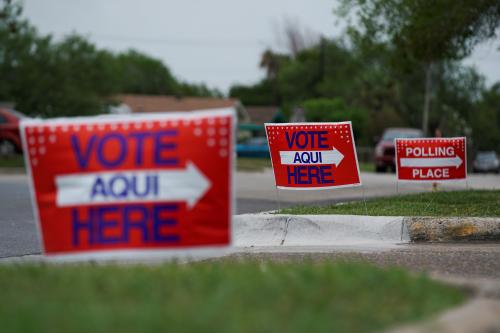Executive Summary
The U.S. media have hindered effective policy making on immigration for decades, and their impact has been increasing in recent years as a result of an ongoing evolution in the media industry. Deeply ingrained practices in American journalism have produced a narrative that conditions the public to associate immigration with illegality, crisis, controversy and government failure. Meanwhile, new voices of advocacy on the media landscape have succeeded in mobilizing segments of the public in opposition to policy initiatives, sometimes by exaggerating the narrative of immigration told by traditional news organizations. The combined effect is to promote stalemate on an issue that is inherently difficult to resolve and that is likely to resurface on the public agenda when a new administration and a new Congress take office in January 2009.
These findings emerge from an examination of how the media have covered immigration going back to 1980 with a special focus on the extended policy debates in 2006 and 2007, which collapsed without producing any significant legislation. Supporters of radically different positions in those debates agree that the current immigration system is broken; one need not favor any particular outcome to conclude that stalemate is a mark of failure in the policy process. Many actors in Washington and beyond played a role in that outcome, and the intent here is not to argue that the media were the decisive players or to rank their influence relative to others. The objective is to understand how the media conditioned public opinion and the policy landscape, and the results show that the media—both traditional journalism and new forms of expression—need to be considered among the factors that contribute to polarization and distrust.
While the immigrant population has grown vastly larger over the years, the terms of the policy debate over immigration have hardly changed in 30 years. Improving border controls; halting the employment of unauthorized migrants; dealing with temporary workers; determining legalization plans for people in the country illegally; refiguring visa categories for legal immigrants—all these topics have been debated repeatedly since at least 1980, and some have actually been legislated. In the meantime, however, the media have undergone a radical transformation marked by declining audiences for the daily newspapers and broadcast network evening news programs that once dominated the information flow and by rising new forms of news delivery via cable television, talk radio and the Internet.
Immigration is a sufficiently important topic to justify attention on its own, but it also serves as an illuminating case study of how the transformation of the media has made the search for compromise on public policy issues more difficult in Washington. Fragmentation of the industry has generated enhanced and more complex competition for audience shares. In response, all forms of news media have become more prone to jump on subjects and produce surges of coverage that convey an air of crisis. When the subject is institutional decision making in Washington, such surges can heighten public anxieties and impede the development of consensus on disputed issues by focusing on political process and gamesmanship rather than the substance of the issues.
In the recent immigration debates of 2006 and 2007, the new media landscape also amplified discrete sectors of public opinion to help block legislative action. In the first act of this drama, the Spanish-language media helped mobilize huge crowds to protest legislation passed by the House that would have mandated an unprecedented crackdown on unauthorized migrants including their jailing on felony charges. The protest marches of spring 2006 were one factor that pushed a bipartisan group of senators to present a counterproposal whose passage kept the other legislation from moving forward.
The new media voices played an even more significant role in the second act of the legislative drama. In 2007, conservative voices on cable television news shows, talk radio and the Internet mobilized opposition to provisions of a Senate bill that would have offered legal status, or “amnesty” as it was labeled, to unauthorized migrants. Meanwhile, liberal commentators and bloggers paid relatively little attention to the issue. Conservatives in the media successfully defined the terms of the debate in a way that helped lead to the eventual collapse of efforts to reach a compromise.
Both cases represented a triumph of “no!” These media sectors proved adept at promoting opposition to specific measures, but they have shown no comparable ability to advance an affirmative agenda. The media have given voice to strongly felt and well-defined views at either end of the policy spectrum. Meanwhile, the broad middle in American public opinion favors a mix of policy options on immigration, but that segment’s views are marked by uncertainty and anxiety about the topic and skepticism about government’s ability to handle it. This reflects the way the immigration narrative has been framed by the media for a generation.
An important but unresolved question is whether these same dynamics apply to other issues that share certain characteristics with immigration. Comprehensive reform of health care and energy policies, like immigration, require the mediation of many competing economic and regional interests while also assuaging strongly felt ideological differences. If the effects of media transformation can be generalized, the recent failures to reach grand bargains on immigration should serve as a cautionary tale.
The conclusions presented here are the author’s alone, but I draw them from the work of several institutions:
- The Project for Excellence in Journalism (PEJ) produced a highly detailed examination of how the media covered immigration in 2007 based on data collected for its News Coverage Index, which is the largest ongoing effort ever to measure and analyze the American news media on a continuing basis. PEJ’s report, “News Coverage of Immigration 2007: A Political Story, Not an Issue, Covered Episodically,” by Banu Akdenizli is based on analysis of 70,737 stories from 48 media outlets in five media sectors.
- At the Brookings Institution, E.J. Dionne Jr. conducted an extensive analysis of public opinion survey data drawn from multiple sources to track the development of attitudes toward immigration and the media’s role in shaping them. His report, “Migrating Attitudes, Shifting Opinions: The Role of Public Opinion in the Immigration Debate,” examines historical trends in segments of the public based on partisanship, ideology and other characteristics and uses new data to probe deeply into the impact of specific media sectors on public opinion during the most recent debate.
- An analysis of the media’s handling of immigration from 1980 to 2007 was conducted at the Annenberg School for Communication at the University of Southern California under this author’s direction. Large bodies of coverage from national and regional newspapers, the Associated Press, the broadcast television networks and National Public Radio were assessed for the volume of coverage, the topics covered and the major attributes of the coverage. In addition, the coverage of several major news stories was examined in greater detail. Coverage of the 2007 immigration debate on five major blogs was also analyzed.
The PEJ and Brookings Institution reports are published in their entirety accompanying the printed version of this report and are available along with other related materials at www. brookings-edu-2023.go-vip.net.
Although the media have undergone an accelerating transformation during the period examined here, there is a great deal of continuity in the approach to immigration. Changes in the media landscape have exaggerated some long-standing tendencies in the coverage and in some cases have taken them to extremes, but the changes have not produced stark turns in new directions. As new “advocacy journalists”—the term CNN’s Lou Dobbs uses to describe himself—have come on the scene, they have framed immigration stories in much the same way as traditional news organizations even while departing from long-established journalistic norms.
While individual stories about immigration may have been entirely accurate, the cumulative effect of U.S. media coverage has distorted the underlying realities of immigration while conditioning audiences in ways that make it more difficult to forge policy compromises. Three major tendencies characterize the way immigration has been covered by the U.S. media:
- The legendary newspaper editor Eugene Roberts of the Philadelphia Inquirer and The New York Times drew a distinction between stories that “break” and those that “ooze.” Immigration is a classic example of a news story that oozes. It develops gradually, and its full impact can be measured only over long periods of time. In contrast, coverage of immigration has been episodic, producing spikes of coverage and then periods when attention falls off. The spikes have been driven by dramatic set-piece events such as the Elian Gonzalez saga, congressional debates and protest marches. The surges in coverage have conditioned the public and policymakers to think of immigration as a sudden event, often tinged with the air of crisis. The biggest of all the surges came with the congressional debates of 2006 and 2007.
- Illegal immigrants have never constituted more than a third of the foreign-born population in the United States, and that mark has been reached only in recent years. Nonetheless, illegal immigration and government’s efforts to control it have dominated the news coverage in all sectors of the media by wide margins for many years. This pattern of coverage would logically cause the public and policymakers to associate the influx of the foreign born with violations of the law, disruption of social norms and government failures.
- Immigrants, in particular, but also policymakers and advocates, have dominated the journalistic narratives to the exclusion of other critical actors, especially employers and consumers. At the simplest level, this has deprived the coverage of essential context by underemphasizing the role of the U.S. labor market in determining the size and characteristics of immigrant flows and overemphasizing the role of government. When their attitudes toward immigration turn negative, audiences exposed to this kind of coverage can readily view immigrants as villains and themselves as victims. Distrust of government—a seeming accomplice or an incompetent protector—is a natural byproduct.
When immigration is associated with crime, crisis or controversy, it makes news. Immigrants and political actors are the primary protagonists of these dramas, while the public is a passive bystander. And as the transformation of the media has taken hold, this pattern has been repeated over and over again for many years with increasing intensity. The breathless, on-and-off coverage—more opera than ooze—has mischaracterized a massive demographic event that has developed over decades and mostly through legal channels. And at the same time, it has helped create contours in public opinion that have rendered the enactment of new immigration policies ever more elusive.
Download the Full Report »
Download the Executive Summary »
Download The Triumph of No: How the Media Influence the Immigration Debate »
Download News Coverage of Immigration 2007:
A Political Story, Not an Issue, Covered Episodically »
Download Appendix A »
Download Appendix B »



